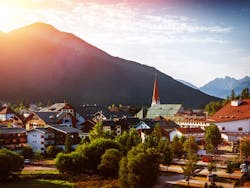Six microgrids are being developed across European alpine states as part of a program designed to foster local energy grids.
The microgrids are being constructed under the ALPGRIDS project, which focuses on creating support for microgrids and a wider understanding of their benefits. Building on six existing pilot sites in five countries, the project aims to develop an alpine microgrid model.
Running until June, the ALPGRIDS Alpine Microgrid Model — one of the outcomes of the ALPGRIDS project — will cover governance, regulation, financing, available technical solutions and market players. It will provide guidance and tools to facilitate the development and implementation of new microgrid projects.
With 12 project partners from five EU member states, ALPGRIDS is being led by the Auvergne-Rhône-Alpes Energy Environment Agency (AURA-EE).
Pilot sites set microgrids
One of the pilot sites is Selnica Ob Dravi, a rural community of 4,600 people in the Drava valley at the eastern end of the Alps in Slovenia. It already has solar photovoltaics (PV) on the primary school’s roof, and future projects include PV for a wastewater treatment plant and fire brigade center.
In Italy, the pilot project will include a feasibility study for a neighborhood microgrid in the city of Savona. The idea is to expand the microgrid architecture already on the nearby Savona campus of the University of Genoa to include a city district. The planned microgrid will consider electricity from local PV plants, thermal energy supplied by traditional heat pumps, geothermal heat pumps, solar collectors and electric boilers, as well as cooling from traditional and geothermal heat pumps. Electric and thermal storage systems are also being considered in order to maximize the use of renewables.
Also in Italy, the city of Udine is developing a pilot project that aims to supply three public buildings — a school, a kindergarten and a museum — and four social housing buildings with a microgrid using high-efficiency combined heat and power as a partial replacement for existing gas-fueled boilers.
In Austria, the WEIZ campus pilot project and the municipality of Thannhausen are focusing on the exchange of electricity generated by an installed PV system within a neighborhood and between different consumers, as well as the implementation of an energy storage system of about 200 kWh.
Val de Quint is a rural area in France of about 760 inhabitants, and its village of Saint-Julien-en-Quint is already involved in microgrid activities with a shared PV system. This village will form a pilot site with the aim of extending the microgrid activities to the entire Val de Quint area.
The pilot site in the German city of Grafing is about 18 miles east of Munich. A retirement home for 43 residents will be built in the center of Grafing with a PV plant on the roof and electric vehicle (EV) charging in the underground car park. The effects of storage and EV charging are being analyzed with this project.
Multiple sites in France
Several pilot sites are also being developed by the AURA-EE in the Drôme region of France. A collective self-consumption program will be set up in which a local PV producer will sell its electricity directly to local consumers. The AURA-EE hopes to identify the best conditions for implementing such projects. The six pilot sites (Saint Marcel-les-Valence, La Roche-de-Glun, Die, Montélier, La Chapelle-en-Vercors, Eurre) are mainly small rural villages where potential PV projects have already been identified.
Overall, the six ALPGRIDS pilot projects are being developed at a total cost of $1.74 million and this includes grants from the European Commission’s European Regional Development Fund worth $1.47 million. The main objective is to increase the uptake of renewables in the Alps through microgrid solutions.
Track news about the microgrids in the European Alpine states. Subscribe to the free Microgrid Knowledge Newsletter.







